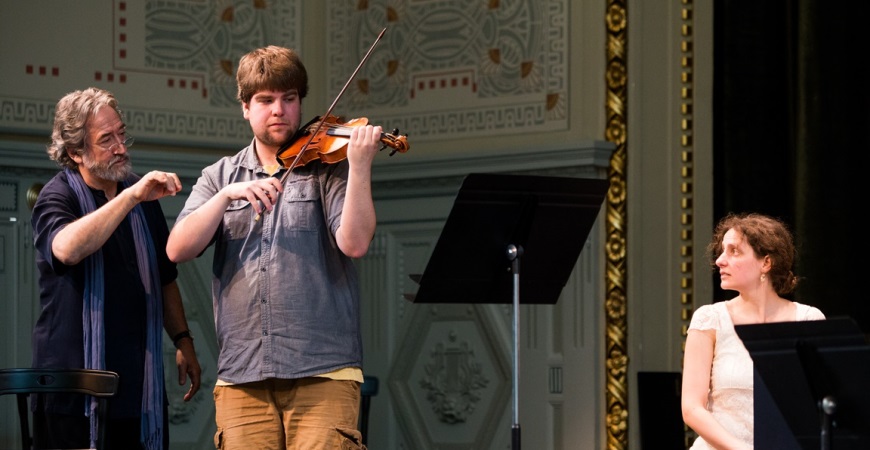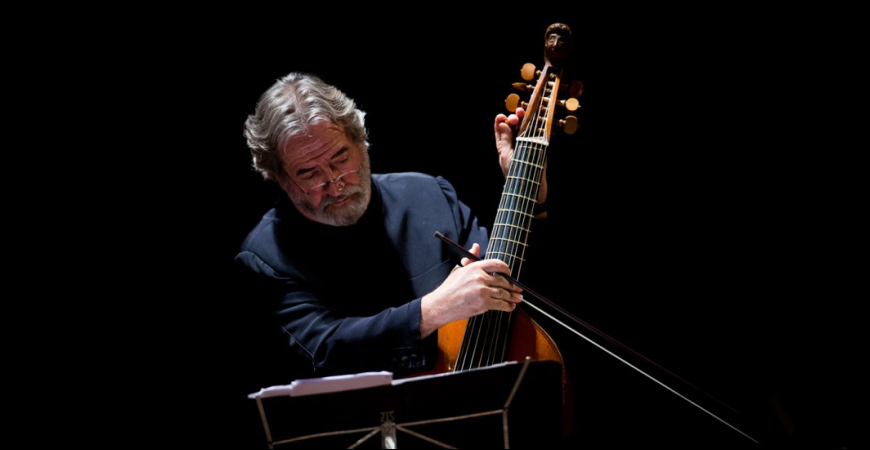Jordi Savall at Liszt Academy
Invited by the Liszt Ferenc Academy of Music, Catalan viola da gamba artist Jordi Savall held a master class in the Solti Hall on the morning of 18 May, while in the evening he performed Bach’s perhaps most complex late masterpiece Musikalisches Opfer (The Musical Offering) with Le Concert des Nations before a full house at the Grand Hall.
Jordi Savall, the apostle of early music performance, carried through his hardly easy program from morning to late night with a vigorousness belying his age of 74. In an article published on the Playliszt blog, Zsombor Németh, who not only went to the evening concert but was also an active participant of the master course, notes that the thematic day comprising the master class and the concert was especially enlightening in the case of early music: “On the one hand, the renowned period performers take quite different or even opposite approaches as to how to interpret the musical repertoire of old times, which makes such pre-performance, introductory workshops highly useful in deepening the audience’s understanding of what is going on in the concert and why. On the other hand, in Hungarian music education the teaching of historic performance practice is regrettably one-sided, therefore it can have a beneficial effect on young musicians to meet artists whose outlook differs partly or completely from the current domestic trends.” Participants at the morning master class included both permanent ensembles and occasional formations. In the course Savall put the emphasis on sonority, that is, the performer’s ability to call forth a natural, almost human, sound from the instrument.
Jordi Savall at the Liszt Academy – click to open photo gallery (photo by Liszt Academy / Zoltán Tuba)
His unique attitude to music was experienced not only by the participants of the master class but also by the audience at the Grand Hall which hosted the full-house last concert of the 2015 Pure Baroque season ticket series, J. S. Bach’s The Musical Offering. Savall’s ensemble, Le Concert des Nations, made up of six members besides the conductor (among them Hungarian cellist Balázs Máté, the artistic director of Aura Musicale and a regular performer at the Liszt Academy) interpreted Bach’s enigmatic work in a unique orchestration and structuring known from their earlier performances and records. Musicologist Zsuzsanna Rákai, the editor of Liszt Academy’s single-evening concert sheets, has summed up her experience as follows: “It was amazing how freely they moved in time, using very special phrasing and ornaments, yet precisely coming together at each formal limit and important accent. A genuine polyphony was thus created in time and form, which was not the grinding of mechanically precise consonances but a kind of strange floating which is brought about by the interplay of independent voices. Savall is my absolute favorite, no one can play any instrument the way he plays the viola da gamba. Listening to him I always have the feeling that his bow is like the shuttle of a handloom, and he is weaving time along with music. He weaves it to the last detail, including the tiniest leaf. When he stops, everything comes to a halt – but when he is playing, all the Norns, the Parcae and the like might as well retire.”
Jordi Savall at the Liszt Academy – click to open photo gallery (photo by Liszt Academy / Zoltán Tuba)
On Origo.hu József Kling praised the performance, calling the theme given to Bach by the King and played by the flute downright space music: “The short royal theme played by the flute is genuine space music: transcendental, otherworldly, elevated, contemplative, crystal clear… a spiritual border-crossing. Each time Marc Hantaï lifted the flute to his mouth, I was thrown into space. I would add that I was lucky enough to be seated very near to the flutist. My friends who were sitting further back looked quite puzzled at the story of my transcendental journey. They, on their part, underlined the outstanding performance of the harpsichordist Pierre Hantaï. This is to be taken literally, since the harpsichord was placed on a podium almost above the orchestra. So far, I liked Pierre Hantaï for his hardcore Scarlatti recordings. Many of my friends thought his play was lacking passion, wildness and emotions in general. But I was content just to hear the variety of tones that he could get out from his otherwise medium-quality instrument.” Zsombor Németh also appreciated the performance of the keyboard player, adding that to hear through Bach’s magnum opus on a par with a treatise in music theory/musicology was quite a challenge to the Budapest audience which is normally accustomed to easier concert programs. However, the critique opined that “the constantly changing colors are appealing enough to sustain the audience’s interest in the musical texture which otherwise offers a rather tiring listening experience even if one does not follow the note. Moreover, by reaching the widest possible variety, the composition gives pleasure even to those less musically trained listeners who have a hard time understanding the complicated musical constructions.”
The concert was followed by the ‘Code’, or public podium discussion led by music historian Endre Tóth and Liszt Academy student Ádám Czinege. The exhaustive, nearly 50-minute talk attracted many people – partly due to the popular and virtuoso encore pieces performed after The Musical Offering. At the end of the evening Jordi Savall, who did not seem tired at all, signed autographs for his fans. Much to the delight of Hungarian audience, the living legend of early music will perform again at the Liszt Academy within the recently announced new Pure Baroque concert series on 11 November 2016, this time leading Concerto Copenhagen.




